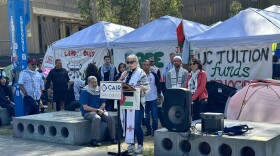Monday, June 5 and Tuesday, June 6, 2023 at 9 p.m. on KPBS TV / Stream now with KPBS Passport!
Ken Burns’ four-hour documentary, BENJAMIN FRANKLIN, explores the life and work of one of the most consequential figures in American history — a prolific writer and publisher, a groundbreaking scientist and inventor, a world-renowned diplomat and a signer of both the Declaration of Independence and the United States Constitution.
Special Feature: Benjamin Franklin’s Life: A Timeline
Franklin, whose life has been celebrated as a quintessential American story, was anything but typical. His 84 years spanned nearly the entirety of the 18th century, an epoch of revolutionary change in science, technology, literature, politics and government — change that Franklin himself helped to advance. He launched the first public library in America, organized a volunteer fire company, and founded an academy that eventually became the University of Pennsylvania.

His annual publication, “Poor Richard’s Almanack,” set a model for future humorists such as Mark Twain and contained maxims that are still part of our shared lexicon. And his famous experiments with electricity led to one of his most important inventions—the lightning rod.
While Franklin was committed to the ideals of the Enlightenment — always looking to improve himself, his community, and humanity at large — he was also full of contradictions. He could be whimsical yet philosophical, folksy yet unforgiving, generous yet shrewdly calculating, and broadminded yet deeply prejudiced.

Critically, especially for a man so associated with independence and individual liberty, Franklin enslaved people and did not become an abolitionist until very late in life. The Franklin household had at least six enslaved individuals, including Peter, Jemima, Othello, George, John and King.
Franklin’s newspaper, The Pennsylvania Gazette, also advertised the sale of enslaved people and published notices of runaways. And while he publicly denounced white settlers who indiscriminately killed Indigenous people, he also championed the expansion of white settlements on to Indigenous lands.
Benjamin Franklin died at age 84. More than 20,000 people — the largest crowd Philadelphia had ever seen — turned out for his funeral procession.
The actor Mandy Patinkin provides the voice of Franklin. Burns called the Patinkin’s reading “distinctive and transcendent,” noting that Patinkin’s voice and timing seem to capture Franklin perfectly, finding just the right sense of humor and curiosity for life that Franklin presented in his many writings.

BENJAMIN FRANKLIN includes interviews with some of the country’s leading scholars of early American history, including Franklin biographer Walter Isaacson, who also served as a senior advisor to the project, as well as the late Bernard Bailyn (Harvard); H.W. Brands (Texas-Austin); Christopher Leslie Brown (Columbia); Joyce Chaplin (Harvard); Ellen R. Cohn (Yale); Philip Dray (New School); Erica Armstrong Dunbar (Rutgers); Joseph J. Ellis (Mt. Holyoke); Clay Jenkinson; William E. Leuchtenburg (UNC); Stacy Schiff; Sheila L. Skemp (Mississippi); and Gordon S. Wood (Brown).
Advisors to the series included H.W. Brands; Joyce E. Chaplin; Ellen R. Cohn; Erica Armstrong Dunbar; William E. Leuchtenburg; Jean M. O'Brien; Page Talbott; and Karin Wulf. Voices were provided by Mandy Patinkin; Carolyn McCormick; Josh Lucas; Paul Giamatti; Liam Neeson; Joe Morton; and Adam Arkin.
EPISODE GUIDE:
Episode 1: “Join Or Die (1706-1774)” Monday, June 5 at 9 p.m. on KPBS TV - After building a printing empire in Philadelphia with his wife Deborah, Benjamin Franklin gains worldwide fame from electricity experiments, then spends years in London trying to keep Britain and America together as his family comes apart.
Episode 2: “An American (1775-1790)” Tuesday, June 6 at 9 p.m. on KPBS TV - In wartime Philadelphia, Benjamin Franklin helps Thomas Jefferson craft the Declaration of Independence. In Paris, he wins French support for the American Revolution. Back home, he works on the Constitution of the new United States.
Watch On Your Schedule:
Episodes are available on demand with KPBS Passport, a benefit for members supporting KPBS at $60 or more yearly, using your computer, smartphone, tablet, Roku, AppleTV, Amazon Fire or Chromecast. Learn how to activate your benefit now.

Credits:
A production of Florentine Films and WETA Washington, D.C., Directed and executive produced by Ken Burns; written by Dayton Duncan; produced by David Schmidt and Ken Burns; co-produced by Katy Haas and Craig Mellish; and associate produced by Emily Mosher. The film was edited by Craig Mellish. The film is narrated by Peter Coyote (HEMINGWAY, COUNTRY MUSIC, THE VIETNAM WAR). Buddy Squires was the lead cinematographer. The executive in charge for WETA is John F. Wilson.
“Benjamin Franklin was a fascinating and complicated individual who helped shape our contemporary world,” said Ken Burns. “If we see him for more than his long list of accomplishments, we recognize an imperfect man challenging himself and his contemporaries as he tries to understand and improve the world around him. One of the best and most prolific writers of the 18th century, Franklin both embodies and documents the dynamic social, scientific and political changes of this revolutionary age. His story is one of hope, with a faith in the common man. But his shortcomings are also a reminder of this country’s failure to address slavery at the time of its founding and the racial divisions that continue to impact our country today.”





